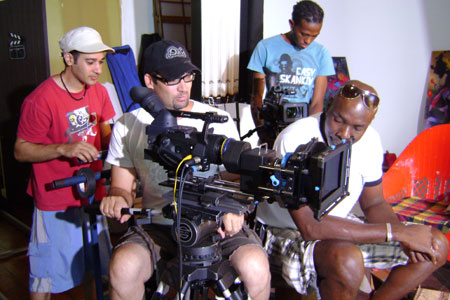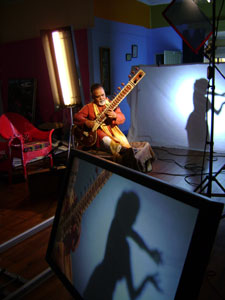- Home
- Movies, Film & Theatre
- Behind the scenes of new T&T film "Seventeen Colours and Sitar"
Behind the scenes of new T&T film "Seventeen Colours and Sitar"
- By TJJ Admin
- Published 08-Sep-10
- Movies, Film & Theatre
- Unrated

Port-Of-Spain, Trinidad (Sonique Solutions) – The new locally produced film “Seventeen Colours and a Sitar” is set to make its debut on the 26th of September during the 2010 Trinidad and Tobago Film Festival. Similar to every major motion picture, theatrical release or creative project, a team of professionals worked tirelessly behind the scenes in order for audiences to eventually experience a work of art.
The unique film direction/production pair of Professor Patricia Mohammed and Michael Mooleedhar may be poised to repeat history by gaining the title of ‘Most Popular Local Short Film’ with this 2010 cinematic effort as happened with last year’s “Coolie Pink and Green”.
Starring British born painter Rex Dixon and Trinidadian musician Mungal Patasar and shot in a documentary style, ‘Seventeen Colours’ gives a one of a kind opportunity for viewers to see two artists from two seemingly opposed genres (a western abstract expressionist artist and an oriental trained classical sitarist) drawn together to explore the similarities and differences in their processes of making their art.
During the pre-production process for this film several time, weather, power and budgetary challenges presented which required careful attention to details from all involved. This included constantly checking weather forecasts and foreseeing possible problems such as electricity failures.
Another challenge arose from the fact that apart from the original music written by Mungal Patasar the film was virtually unscripted and depended on what happened on the set. Although certain aspects were pre-planned e.g. the priming of canvases and the pre-mixing of paints by Rex Dixon and the pre-conception of certain dance sequences, the rest was to be elicited from the making of art and performances in front of the camera.
Amidst these trials the cast and crew of ‘Seventeen Colours’ stayed committed to the cause of delivering novel Caribbean production to the public. For their endurance they were rewarded with rich, interesting, educational and often enjoyable experiences.
Professor Mohammed shared, “there were exciting moments in shooting when you knew as a director that what was happening in front of the camera was going to be a ‘money shot’ in the film or that a particular statement made by the artists would be valuable for the film dialogue. Michael and I would intuitively recognize this and then ensure that we got the footage we might require or ask for a repeat of the point being made”.
 Other notable onset occurrences included a moment when members of the crew discovered their own inner dancer while creating an impromptu dance arrangement to the backdrop of Patasar’s sitar solo and the on the spot jam session between Dixon and Rapso group 3 Canal as they painted while singing an extempore version of their hit song “Blue” (which also appears in the film’s soundtrack).
Other notable onset occurrences included a moment when members of the crew discovered their own inner dancer while creating an impromptu dance arrangement to the backdrop of Patasar’s sitar solo and the on the spot jam session between Dixon and Rapso group 3 Canal as they painted while singing an extempore version of their hit song “Blue” (which also appears in the film’s soundtrack). When asked about her co-director Professor Mohammed said, “Michael and I have been working together now in a few films and we have found a way to combine our skills effectively and to think for each other during both the making of and promotion of a film. He is immensely talented and I am thankful that he has supported my idiosyncratic approach to film making”.
Michael Mooleedhar explained that for him directing and editing “Seventeen colours and a Sitar” was a breath of fresh air and that he was now inspired to paint. This experience gave him the challenge of figuring out a way to execute a film differently while keeping it entertaining and giving the audience as much information as possible.
Mooleedhar further stated, “Patricia Mohammed and I work very well together; she is quick and thinks out of the box, so you know the experience will be different”.
Both directors thank and respect every cast and crew member for their patience, support, talent and for their readiness to go the extra mile in order to make things work. They also underscore the importance of the roles of lighting technicians and cinematographers in film making and praise the film’s Director of Photography, Reginald Pollard for his professionalism, his flexibility and also the talent he brought to the project. Pollard is further lauded for bringing a certain voyeuristic look and feel to the film and for his willingness to repeat a shot until it was done absolutely right. He is referred to as an artist behind the lens.
“Seventeen Colours and a Sitar” is about painting and music and making art. While there has been a recurrence of films in previous film festivals that have dealt with artistic figures or issues, this modern day east meets west offering attempts to bring two artists together to talk about their work, and to actually create some of this fusion between two disparate art movements before the camera.
According to several film and art documentary aficionados this is also the first time that such a film has been made in the Caribbean.
The film shows at the following dates and locations: Sunday 26 Sept. at 5.30pm (MovieTowne, Chaguanas); Monday 27 Sept at 5.30pm and Friday 1 October at 3pm (MovieTowne, Invaders Bay); and Friday 1st October at 4pm (University of the West Indies, St. Augustine).
For more information on “Seventeen Colours and a Sitar”:
Log onto: http://www.facebook.com/seventeencoloursandasitar